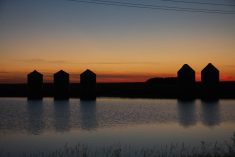BASHAW, Alta. — When Dave Fox moved to a farm just outside Stettler, he had two old existing water wells capped and a new well drilled.
If the new water well was going to be his main source of drinking water, Fox wanted to know more about the well and how to maintain it.
“I want to get a better understanding of the working of the well and hopefully save money down the road,” said Fox during a Working Well workshop hosted by the County of Stettler and Camrose County.
Read Also

Know what costs are involved in keeping crops in the bin
When you’re looking at full bins and rising calf prices, the human reflex is to hold on and hope for more. That’s not a plan. It’s a bet. Storage has a price tag.
“I have the information about the well, but I want a better understanding of it.”
Each year 3,700 new domestic water wells are drilled in Alberta, with the majority in the heavily populated areas around Calgary, Edmonton and the Highway 2 corridor connecting Alberta’s two main cities.
Ken Williamson, a former Alberta Agriculture water specialist and now a water consultant, said only half the people he talks to have seen their well driller’s report, the mandatory report filed with the province detailing everything about the well.
The Water Well Drilling Report is an important resource for homeowners wanting a better understanding of their water well.
About 20 percent, or 60,000 Albertans, rely on the 500,000 domestic water wells in the province. Across Canada, 30 percent of the population uses groundwater for domestic purposes.
During the day-long workshop, Williamson had each homeowner take the information from their own water well report and draw it on a specially designed page to help each person visualize the construction of their water well.
The participants drew in the depth of the borehole, the type of screen used at the bottom of the well, the depth of the surface casing, the type of soil surrounding the well, the static water level and what was used to seal the well from contaminants.
Rick Hicks, of Bittern Lake, Alta., drew a diagram from his water well report and caught an error on the report of his newly drilled well.
“Something in it doesn’t make sense,” said Hicks, of the bentonite chips placed around the bore to seal the well from impurities. Hicks learned the chips weren’t at the right depth during the workshop.
“I wanted to learn about water wells. I just moved from Calgary and this was a good opportunity to learn something. Nobody else is going to look after it for me.”
Jennifer Macpherson with Alberta Environment said unlike water in towns and cities, where staff are hired to ensure the water is safe, in the country no one is checking the wells.
“It is your responsibility to take care of your well and ensure you have a safe and secure drinking supply,” Macpherson told the group at the workshop.
“Proper maintenance ensures the well stays good for as long as it can.”
The average household uses 200 to 250 gallons of water each day. Knowing how quickly the well recharges will help maintain the quality of water and longevity of the well.
One of the biggest problems with wells is over-pumping, or pumping water out faster than it can flow into the well.
“Don’t over-pump your well,” said Macpherson several times throughout the day.
Local water well driller Cliff Buelow of Cliff’s Drilling said the biggest problem he sees is people leaving the cap off the well and allowing mice and insects to fall in.
Buelow said he likes it when owners are around and asking questions while he’s drilling a well. For Buelow, it’s a good opportunity to explain how the well works and increase the likelihood of better well maintenance.
The other problem Buelow sees is wells located at the low spot in the yard where water, manure and other contaminants can run in. He also discourages homeowners from disguising their wells with flowerpots or decorative items that attract insects.
Margaret Purdy of Scenic Sands, a summer village near Bashaw, Alta., said she came to the workshop to find out more about the well at her new retirement home.
“This is just proactive to know what to look for and be aware of.”
While shock chlorinating water wells may not solve all water problems, it cures many, Leask told landowners at a water well workshop.
A build up of slime inside the toilet tank, staining of bathroom fixtures and laundry, bad smells and tastes are often a sign of sulphate-reducing bacteria that can cause permanent damage to well equipment.
Pouring the mixture of chlorine and water into the well and following the proper protocol is an easy step to maintaining safe water, said Leask.
“To be effective, it has to be done regularly.”
- Store enough water for eight to 48 hours of farm and family use.
- Bypass water treatment equipment.
- Prepare mixture of chlorine and water in large water tank.
- Siphon chlorine solution into well using clean garden hose.
- Open all hydrants, faucets and run until you can smell chlorine at each outlet.
- Shut off taps and don’t use water for 8 to 48 hours.
- Open an outside tap and run outside faucet until chlorine smell disappears. Do not run on sensitive plants or landscaping.
- Run hot and cold taps inside the house to flush the hot water tank and distribution system. The trace of water remaining in the system will not harm the septic system.














